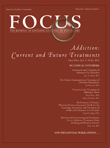Performance in Practice: Physician Practice Assessment Tools for the Screening, Assessment, and Treatment of Adults with Substance Use Disorder
Abstract
The American Board of Medical Specialties (ABMS) and the American Board of Psychiatry and Neurology (ABPN) are implementing multifaceted Maintenance of Certification (MOC) requirements to enhance quality of patient care and assess and verify the competence of physicians over time (ABPN 2009). Beginning in 2013, for those applying for 2014 MOC examinations, the practice assessment component (Part 4 of MOC) will require physicians to compare their care for five or more patients with “… published best practices, practice guidelines or peer-based standards of care and develop a plan to improve effectiveness and efficiency of his or her clinical activities” (ABPN 2009). To this end, the Performance in Practice Physician Practice Assessment Tools for the Screening, Assessment, and Treatment of Adults with Substance Use Disorder that are presented here provide psychiatrists with the opportunity to gain experience with practice assessment, in preparation for the new ABMS and ABPN MOC requirements. Because the evidence-based quality indicators included in the tools presented here are considered core components in the care of patients with substance use problems or disorders, use of these tools can serve as a foundation in developing a systematic approach to practice improvement for the assessment and treatment of patients with substance use disorders.
Alcohol, tobacco, and other substance use disorders are among the most common medical problems in patients presenting in primary care and specialty mental health settings. In the United States, it is estimated that one in seven adults will have an alcohol or other substance use disorder over the course of his or her lifetime (1). Alcohol and nicotine disorders are most prevalent. Nearly one-third of U.S. adults drink enough to cause or place them at risk of adverse consequences (2), whereas 28% of the population aged 12 or older use tobacco products and 9% have used illicit drugs in the past month (3). Individuals with substance use disorders have very high rates of morbidity, mortality, and functional impairment, as well as significantly higher medical costs associated with their disproportionate use of health care resources (4–8). Alcohol and tobacco use are two of the nation's leading causes of death from modifiable factors (8, 9). Moreover, substance use disorders are common comorbidities among individuals with mood, anxiety, and other mental disorders (5). Longitudinal studies suggest that individuals with these diagnoses are at an increased risk for the later onset of nicotine, alcohol, and illicit drug dependence (10).
Despite the availability of effective treatments and preventative interventions (11–18), only a minority of patients receive care of any type, and there is generally a 10-year gap between the onset of these disorders and first treatment, according to studies of treatment access in the United States (8, 19–21). Systematic assessments of the quality of general medical and specialty mental health care in the United States indicate that patients with substance use problems and disorders receive the poorest overall quality of care compared with that for individuals with other conditions (22). A major national study of care quality in primary care practices found that only 11% of patients with alcohol dependence received what the study described as indicators of quality care, including assessment of alcohol dependence among binge drinkers and treatment referral for individuals with a diagnosis of alcohol dependence (22).
Among psychiatric patients treated in routine practice settings in the United States, approximately one-quarter were identified by their treating psychiatrist as having a current substance use disorder (23); however, the majority of these patients were not reported to be receiving current treatment for these conditions. For example, 91% of patients identified as having nicotine dependence were not receiving any smoking cessation treatments (24). Similarly, nearly 7 of 10 patients with identified alcohol dependence and 6 of 10 patients with other identified substance use disorders were not receiving treatment for these disorders from their psychiatrist or any other clinician. Although medications to treat other mental health conditions are commonly used by psychiatrists, medications to treat substance use disorders are rarely used in routine psychiatric practice settings (25). These findings underscore the fact that clinical assessment and treatment of substance use and related disorders represents a tremendous opportunity to improve clinical practice in an area of medicine associated with high morbidity and mortality (4–8).
The American Board of Medical Specialties (ABMS) and the American Board of Psychiatry and Neurology (ABPN) are now moving to implement multifaceted Maintenance of Certification (MOC) requirements to enhance quality of patient care and assess and verify the competence of physicians over time (26). Beginning in 2013, for those applying for 2014 MOC examinations, a practice assessment component of maintenance of certification will require physicians to compare their care for five or more patients with “… published best practices, practice guidelines or peer-based standards of care and develop a plan to improve effectiveness and efficiency of his or her clinical activities” (26). Because the assessment and treatment of substance use disorders reflects a clinical area of great opportunity to improve clinical practices and ameliorate the immense burden of disease and suffering associated with these conditions, these Performance in Practice: Physician Practice Assessment Tools for the Screening, Assessment, and Treatment of Adults with Substance Use Disorder were developed to meet the new ABMS and ABPN MOC requirements.
These performance in practice (PIP) tools were developed by first identifying evidence-based assessment and treatment recommendations from the following sources: the American Psychiatric Association's (APA's) “Practice Guideline for the Treatment of Patients with Substance Use Disorders” (2006) (11); APA's “Guideline Watch: Practice Guideline for the Treatment of Patients with Substance Use Disorders” (2007) (12); the Veteran's Administration (VA)/Department of Defense (DoD) “Clinical Practice Guideline: Management of Substance Use Disorder (SUD)” (2009) (13); U.S. Department of Health and Human Services “Clinical Practice Guideline: Treating Tobacco Use and Dependence: 2008 Update” (2008) (14) and Varenicline criteria for prescribing (updated February 2010) (15); the National Institute on Alcohol Abuse and Alcoholism (NIAAA): A Clinician's Guide (2005) (16); the NIAAA Prescribing Medications for Alcohol Dependence (2008) (17); the National Institute for Health and Clinical Excellence, NICE Clinical Guideline: Drug Misuse—Opioid Detoxification (2007) (18); and APA's Practice Guideline for Psychiatric Evaluation of Adults (2006) (27). These evidence-based guidelines were developed through systematic medical literature reviews and critical evaluation of the scientific research by experts in the assessment and treatment of substance use disorders. Consequently, the physician PIP Tools presented here are based on the best available current medical research and evidence-based recommendations for the assessment and treatment of substance use disorders.
These Performance in Practice: Physician Practice Assessment Tools for the Screening, Assessment, and Treatment of Adults with Substance Use Disorder are specifically intended to do the following:
| 1. | Provide simple assessment tools for physicians to examine the care provided to systematically selected adult patients to assess whether the clinician's current patient assessment and treatment practices for alcohol, tobacco, opiate and other substance use disorders are consistent with the latest evidence-based recommendations. | ||||
| 2. | Offer valuable clinical resources (including easily accessible sources for brief screening, assessment, and treatment interventions) and key evidence-based recommendations for clinicians to use if they identify areas in which additional knowledge or modifications to clinical practices may help improve clinical assessment and treatment practices. | ||||
| 3. | Provide a brief, practical, easy-to-use tool that in the future may be used to meet the new ABMS and ABPN maintenance of certification requirements for assessments of clinical practice with the aim of enhancing the quality of patient care. | ||||
The PIP clinical tools have been designed to be relevant across clinical settings (e.g., inpatient and outpatient), straightforward to complete, and usable in a pen-and-paper format to aid adoption. In addition to its value as a practice-assessment tool, this form could be also used for retrospective peer-review initiatives. Although the ABPN MOC program requires review of at least five patients as part of each PIP unit, it is important to note that larger samples will provide more accurate estimates of quality of care within a practice.
After using the PIP tool to assess the pattern of care provided to patients, the physician should determine whether specific aspects of care need to be improved. Through such practice assessment, the physician may determine that deviations from the quality indicators are clinically appropriate and justified or he or she may choose to acquire new knowledge and modify his or her practice to improve quality. For example, if patients in the physician's current psychiatric caseload are not screened for tobacco or alcohol use, then an area for improvement could involve implementation of systematic screening for alcohol and tobacco use, which are common among patients with any psychiatric disorders.
It is important to note that although these tools are intended to highlight current evidence-based assessment and treatment recommendations for patients with or at risk for developing substance use disorders, justifiable variations from recommended care are expected. Assessment and treatment recommendations provided in the practice guidelines are generally intended to be relevant to the majority of individuals (28, 29). However, patients vary widely in their clinical presentations, presence of comorbid physical and psychiatric conditions, response to treatment, and other factors that may influence clinical decision making. In addition, practice guidelines and quality indicators are often derived from findings of efficacy and effectiveness trials in which stringent enrollment criteria are used; thus individuals in clinical trials often differ in important ways from those seen in routine clinical practice (30). To this end, divergence from evidence-based recommendations can be anticipated. Finally, the PIP tools need to be updated regularly to keep pace with the growing scientific base for the assessment and treatment of substance use disorders.
The PIP tools presented in Appendices 1 and 2 provide clinicians with an opportunity for practice assessment in preparation for the new 2014 ABPN MOC program requirements. Because the evidence-based quality indicators presented here are considered core components in the care of patients with substance use problems or disorders, use of this tool can serve as a foundation in developing a systematic approach to practice improvement for the assessment and treatment of patients with substance use disorders.
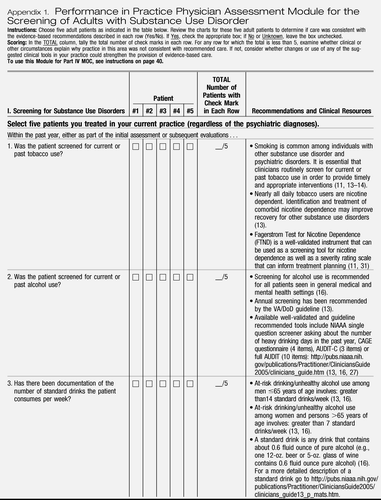 |
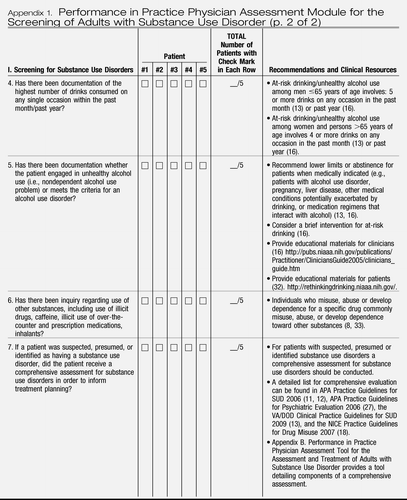 |
Appendix 1. Performance in Practice Physician Assessment Module for the Screening of Adults with Substance Use Disorder
Instructions: Choose five adult patients as indicated in the table below. Review the charts for these five adult patients to determine if care was consistent with the evidence-based recommendations described in each row (Yes/No). If Yes, check the appropriate box; if No or Unknown, leave the box unchecked.
Scoring: In the TOTAL column, tally the total number of check marks in each row. For any row for which the total is less than 5, examine whether clinical or other circumstances explain why practice in this area was not consistent with recommended care. If not, consider whether changes or use of any of the suggested clinical tools in your practice could strengthen the provision of evidence-based care.
To use this Module for Part IV MOC, see instructions on page 40.
 |
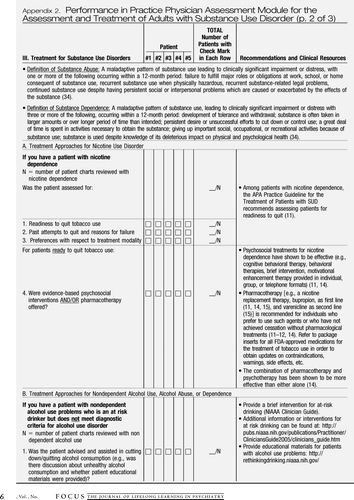 |
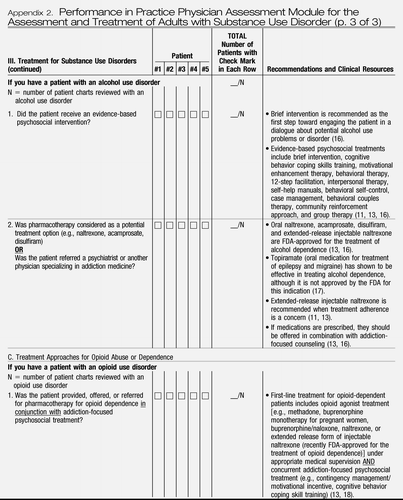 |
Appendix 2. Performance in Practice Physician Assessment Module for the Assessment and Treatment of Adults with Substance Use Disorder
Instructions: Choose five adult patients as indicated in the table below. Review the charts for these five adult patients to determine if care was consistent with the evidence-based recommendations described in each row (Yes/No). If Yes, check the appropriate box; if No or Unknown, leave the box unchecked.
Scoring: In the TOTAL column, tally the total number of check marks in each row. For any row for which the total is less than 5, examine whether clinical or other circumstances explain why practice in this area was not consistent with recommended care. If not, consider whether changes or use of any of the suggested clinical tools in your practice could strengthen the provision of evidence-based care.
To use this Module for Part IV MOC, see instructions on page 40.


1 Kessler RC, Berglund P, Demler O, Jin R, Merikangas KR, Walters EE: Lifetime prevalence and age-of-onset distributions of DSM-IV disorders in the National Comorbidity Survey Replication. Arch Gen Psychiatry 2005; 62:593–602Crossref, Google Scholar
2 Dawson DA, Li TK, Grant BF: A prospective study of risk drinking: at risk for what? Drug Alcohol Depend 2008; 95:62–72Crossref, Google Scholar
3 Substance Abuse and Mental Health Services Administration: Results from the 2009 National Survey on Drug Use and Health: Vol. 1. Summary of National Findings. NSDUH Series H-38A, HHS Publication SMA 10-4586Findings. Rockville, MD, Office of Applied StudiesGoogle Scholar
4 Schneider Institute for Health Policy: Substance Abuse: The Nation's Number One Health Problem, 2nd Ed. Princeton, NJ, The Robert Wood Johnson Foundation, 2001. http://www.rwjf.org/files/publications/other/SubstanceAbuseChartbook.pdfGoogle Scholar
5 Kessler RC: The epidemiology of dual diagnosis. Biol Psychiatry 2004; 56:730–737Crossref, Google Scholar
6 Annual Medical Examiner Data 1990: Data from the Drug Abuse Warning Network (DAWN) Statistical Series: Series 1, Number 10-B. DHHS Publication (ADM) 91-1840. Rockville, MD, US Department of Health and Human Services, National Institute on Drug Abuse, 1991Google Scholar
7 Centers for Disease Control: Alcohol-related mortality and years of potential life lost: United States, 1987. MMWR Morb Mortal Wkly Rep 1990; 39:173–177Google Scholar
8 Hasin DS, Stinson FS, Ogburn E, Grant BF: Prevalence, correlates, disability, and comorbidity of DSM-IV alcohol and dependence in the United States: results from the National Epidemiologic Survey on Alcohol and Related Conditions. Arch Gen Psychiatry 2007; 64:830–842Crossref, Google Scholar
9 Mokdad AH, Marks JS, Stroup DF, Gerberding JL: Actual causes of death in the United States, 2000 [published corrections appear in JAMA 2005; 293:293–294, 298]. JAMA 2004; 291:1238–1245Crossref, Google Scholar
10 Swendsen J, Conway KP, Degenhardt L, Glantz M, Jin R, Merikangas KR, Sampson N, Kessler RC: Mental disorders as risk factors for substance use, abuse and dependence: results from the 10-year follow-up of the National Comorbidity Survey. Addiction 2010; 105:1117–1128Crossref, Google Scholar
11 Work Group on Substance Use Disorders: Treatment of patients with substance use disorders, 2nd edition. American Psychiatric Association. Am J Psychiatry 2006; 163(8 suppl):5–82. http://www.psychiatryonline.com/pracGuide/pracGuideChapToc_5.aspxCrossref, Google Scholar
12 Connery HS, Kleber HD: Guideline Watch (April 2007): Practice guideline for the treatment of patients with substance use disorders, 2nd edition. Focus 2007; 5:163–166. http://www.psychiatryonline.com/content.aspx?aid=149073Link, Google Scholar
13 Management of SUD Working Group. VA/DOD Clinical Practice Guideline: Management for Substance Use Disorders (SUD). Washington, DC, Department of Veteran's Affairs, Department of Defense, 2009. http://www.healthquality.va.gov/Substance_Use_Disorder_SUD.aspGoogle Scholar
14 Clinical Practice Guideline: Treating tobacco use and dependence: 2008 update. Bethesda, MD, U.S. Department of Health and Human Services, 2008. http://www.surgeongeneral.gov/tobacco/treating_tobacco_use08.pdfGoogle Scholar
15 VA Center for Medication Safety, Tobacco Use Cessation Technical Advisory Group, Public Health Strategic Healthcare Group, VA Pharmacy Benefits Management Services, VISN Pharmacist Executives, Medical Advisory Panel: Varenicline criteria for prescribing. Updated Feb 2010. http://www.healthquality.va.gov/Management_of_Tobacco_Use_MTU.aspGoogle Scholar
16 Helping Patients Who Drink Too Much: A Clinician's Guide. NIH Publication 07-3769. Bethesda, MD, National Institute on Alcohol Abuse and Alcoholism, 2005 ed., reprinted May 2007. http://pubs.niaaa.nih.gov/publications/Practitioner/CliniciansGuide2005/clinicians_guide.htmGoogle Scholar
17 Prescribing Medications for Alcohol Dependence. NIH Publication 07-3769. Bethesda, MD, National Institute on Alcohol Abuse and Alcoholism, October 2008. Update http://www.niaaa.nih.gov/Publications/EducationTrainingMaterials/Documents/PrescribingMeds.pdfGoogle Scholar
18 National Institute for Health and Clinical Excellence: Drug Misuse: Opioid Detoxification. National Clinical Practice Guideline number 52. London, Alden Press, 2007. http://guidance.nice.org.uk/CG52Google Scholar
19 Wang PS, Lane M, Olfson M, Pincus HA, Wells KB, Kessler RC: Twelve-month use of mental health services in the United States: results from the National Comorbidity Survey Replication. Arch Gen Psychiatry 2005; 62:629–640Crossref, Google Scholar
20 Substance Abuse and Mental Health Services Administration: Results From the 2004. National Survey on Drug Use and Health: National Findings. DHHS Publication (SMA) 05-4062. Rockville, MD, Office of Applied Studies, 2005Google Scholar
21 Dawson DA, Grant BF, Stinson FS, Chou PS, Huang B, Ruan WJ: Recovery from DSM-IV alcohol dependence: United States, 2001–2002. Addiction 2005; 100:281–292Crossref, Google Scholar
22 McGlynn EA, Asch SM, Adams J, Keesey J, Hicks J, DeCristofaro A, Kerr EA: The quality of health care delivered to adults in the United States. N Engl J Med 2003; 348:2635–2645Crossref, Google Scholar
23 Wilk JE, West JC, Narrow WE, Marcus SC, Rubio-Stipec M, Rae DS, Pincus HA, Regier DA: Comorbidity patterns in routine psychiatric practice: is there evidence of underdetection and underdiagnosis? Compr Psychiatry 2006; 47:258–264 Epub; 2006. April 19.Crossref, Google Scholar
24 Montoya ID, Herbeck DM, Svikis DS, Pincus HA: Identification and treatment of patients with nicotine problems in routine clinical psychiatry practice. Am J Addict 2005; 14:441–454Crossref, Google Scholar
25 Montoya I, Svikis D, Marcus S, Suarez A, Tanielian T, Pincus HA: Psychiatric care of patients with depression and comorbid substance abuse disorders. J Clin Psychiatry 2000; 61:698–705Crossref, Google Scholar
26 American Board of Psychiatry and Neurology, Inc.: Maintenance of Certification program. Buffalo Grove, IN, American Board of Psychiatry and Neurology, Inc., 2009. http://www.abpn.com/downloads/moc/moc_web_doc.pdfGoogle Scholar
27 Work Group on Psychiatric Evaluation of Adults: Psychiatric evaluation of adults, 2nd edition. American Psychiatric Association. Am J Psychiatry 2006; 163(6 suppl):3–36. http://www.psychiatryonline.com/pracGuide/pracGuideChapToc_1.aspxCrossref, Google Scholar
28 Dickey B, Sederer LI (eds): Improving Mental Health Care: Commitment to Quality. Washington, DC, American Psychiatric Publishing, Inc., 2001Google Scholar
29 Eddy DM: Practice policies: Where do they come from? JAMA 1990; 263: 1265–1269, 1272Crossref, Google Scholar
30 Zarin DA, Young JL, West JC: Challenges to evidence-based medicine: a comparison of patients and treatments in randomized controlled trials with patients and treatments in a practice research network. Soc Psychiatry Psychiatr Epidemiol 2005; 40:27–35Crossref, Google Scholar
31 Fagerstrom KO, Schneider NG: Fagerstrom Test for Nicotine Dependence, in Handbook of Psychiatric Measures, 2nd ed. Edited by Rush AJ, First MB, and Blacker D. Rosslyn, VA, American Psychiatric Publishing Inc., 2008, pp 448–449Google Scholar
32 Rethinking Drinking: Alcohol and Your Health. NIH Publication 10-3770. Bethesda, MD, National Institute on Alcohol Abuse and Alcoholism, Revised April 2010. http://rethinkingdrinking.niaaa.nih.gov/Google Scholar
33 Compton WM, Thomas YF, Stinson FS, Grant BF: Prevalence, correlates, disability, and comorbidity of DSM-IV Drug Abuse and Dependence in the United States: Results from the National Epidemiologic Survey on Alcohol and Related Conditions. Arch Gen Psychiatry. 2007; 64:566–576Crossref, Google Scholar
34 American Psychiatric Association. Diagnostic and Statistical Manual of Mental Disorders, 4th Edition Text Revision. Washington, DC, American Psychiatric Association. 2005Google Scholar


